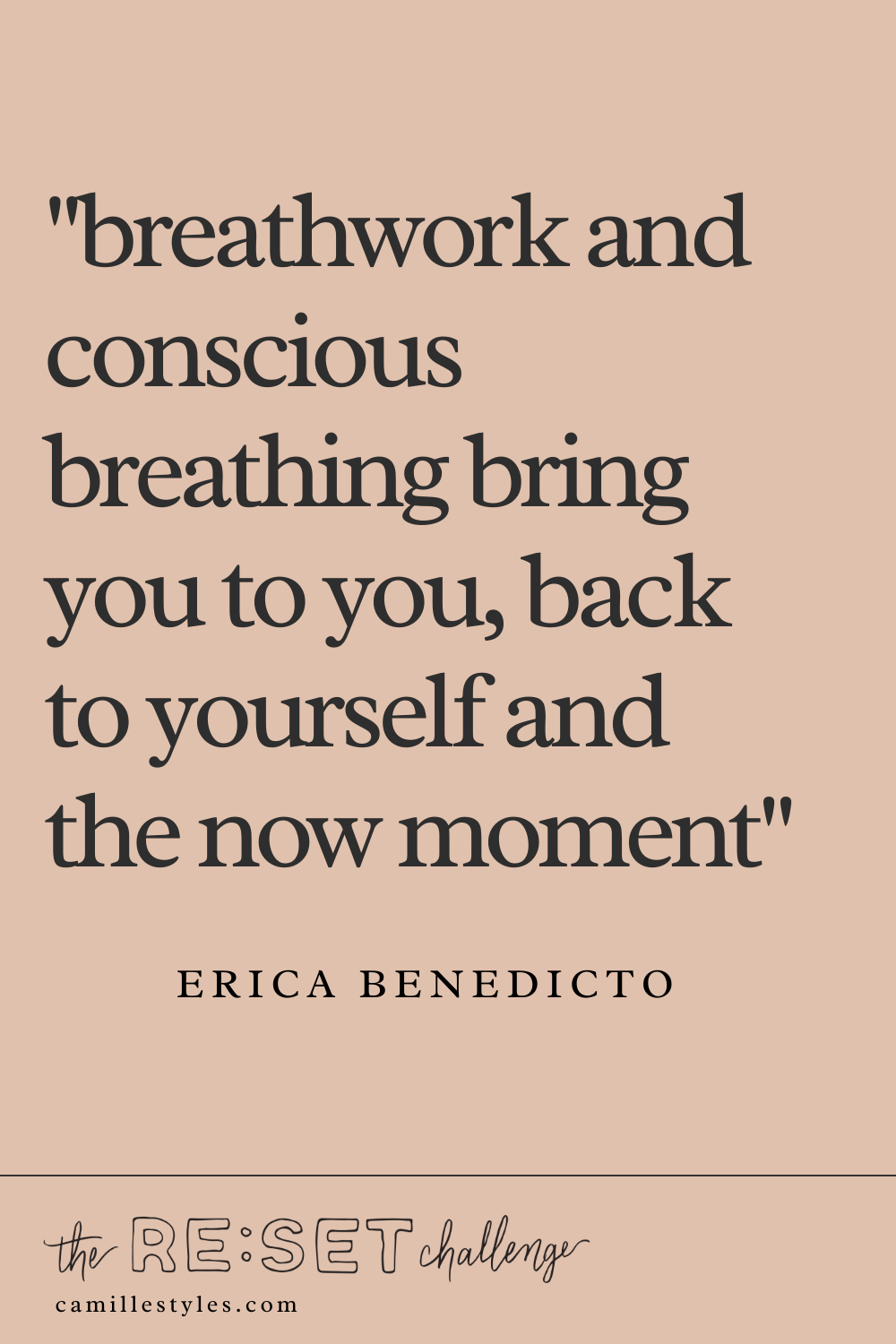There’s way more to wellness than just eating clean, so we’re taking a holistic approach to restoring our spaces, minds, bodies, and hearts in small but powerful ways. Introducing The RE:SET Challenge—a 21-day plan to a healthier and happier you. Click here for the full list. Up next, what is breathwork and how to do a guided breathwork exercise. 
If you’ve been feeling anxiety, stress, tension, or just general overwhelm lately then don’t worry, you’re not alone. In 2019, a poll found that Americans are among the most stressed people in the world and that was before COVID. Pandemic stress has taken its toll with a widespread increase in anxiety, and sleepless nights.
So, how do we calm our nerves and relieve panic in an unprecedented world? Enter breathwork. Yes, we breathe unconsciously all day every day but breathwork is a very conscious practice. To explore this ancient exercise, we tapped Erica Benedicto, MPAS, MPH, PYT-300, founder of The Medicine Inside & Flow Mama Flow Community. Known as a medicine mama to the community (and now a real mama to M Sol) Erica brings 22 years of healthcare experience (and 13 as a PA-C) living and working within marginalized communities. Her mission? To help people remember the healer within and return to their natural magic.
“Breathwork is an enormous piece of what I call The Medicine Inside,” she tells me. “Your breath is always available and accessible to you in all moments. It’s a truly beautiful gift that we all have. Beyond the physical benefits, breath takes us to another level emotionally, mentally and spiritually. For me, the most important aspect of breath is the return to me.”
Read on to learn more about breathwork, what it is, why it works, along with a simple exercise to get started.

image by Riley Blanks
So, what is breathwork exactly?
If you’re feeling clueless too, then don’t stress. We asked Benedicto to break it down for us in simple terms and we’re so glad she did. According to Benedicto, breathwork is a general term for “a variety of techniques that allow conscious control of the breath in order to enhance and elevate physical, mental, emotional and spiritual well-being and overall health.” Oh, and it’s been around for millennia!
“It’s the only way we’ve been able to live and evolve—it’s truly our life force,” she continues. “Depending on the tradition of the technique, the history varies, but all lineages and all of our ancestors knew how important breath is. Evolutionarily, the breath is something that speeds up and shallows involuntarily when we’re in the sympathetic nervous system, ‘fight or flight’ mode. When we slow the breath and consciously breathe deeper and to our full lung capacity, it places us into the parasympathetic nervous system, our calm, connect, rest, and digest mode.”
What does breathwork do and how does it help?
You all know how good it feels to take a long, deep breath, well, breathwork is based on that simple principle. But how often do you sit with your breath and consciously slow and deepen the breath? Benedicto says this simple act places our mind and body into a calm and more relaxed state. “When we’re stressed out or in worried mode, our breath is found and felt in the upper chest,” she explains. “We forget, we are unable to focus, we ruminate and just go on autopilot. When we control the breath, we can reach all the way down to the diaphragm, deep into the belly, allowing for a fuller, slower, and more present human experience. We gain clarity and creativity, we open and allow. We get a glimpse into our consciousness and often our soul. Breathwork and conscious breathing bring you to you, back to yourself and the now moment.”

How often should we do breathwork?
Well, the answer for this one is simple: All the time! As many of you reading this know first hand, we live in an “always-on” culture or what Benedicto terms ‘the sympathetic society’ that’s constantly worrying about the future or bellyaching about the past with our breath up in the chest, shallow and short. “The mind does not know the difference between real and imagined,” she says. “The stories we constantly play and replay become our reality and keep us in that shorter, shallow breathing space. Really focusing on the breath as much as possible takes you out of the past and the future and into the now. The more we practice, the easier it is to get into that more relaxed and calm state on a more frequent basis.”
Why is breathwork so effective?
If you want to truly understand why breathwork is so powerful, you have to start. Benedicto says the effectiveness is in the exchange that occurs, the physiological effect. “When we get a full inhale, we take in essential oxygen that invigorates our cells, our organs, all of the systems, our entire body and exhale carbon dioxide,” she outlines. “Carbon dioxide is a weak acid and when too much builds up, it places extra stress on our nervous system, keeping us in that fight or flight. Breath is our life force, the universal force.”
She adds: “In yogic traditions, pranayama is the 4th limb and the control of the breath. Full and deep belly breaths are how we’re meant to live and thrive unless we’re in true danger. There are so many evidence-based studies done on pranayama and its benefits in boosting the immune system, heart health, decreasing blood pressure, asthma, anxiety, brain function, and even cancer.
“On a deeper level, because our inside world colors our outside one, when we are in a calm and peaceful state and our body feels fully relaxed, our lens and perspective change. It’s both a biological and a spiritual shift and with the right breath we gain a more expansive view of all the goodness that life has to offer.”

When should you use breathwork?
If Benedicto had her way, as often as possible! The more we sit throughout the day, the less opportunity we get to breathe to our full lung capacity, so the more we can practice, the better. Plus, Benedicto says the more we do it the easier it gets. “Eventually it becomes your go-to in times of chill, joy, and in times of stress or struggle,” she says.
What happens to your physical body during breathwork?
Be prepared to feel different physical sensations when you start practicing breathwork. This is because physiologically, we’re alkalizing the body, something that you may not be used to feeling physically. “Some people feel lighter and looser,” she says. “As time goes on and you really start to turn up the oxygen, you may feel a bit lightheaded, buzzy or tingly. The more physical sensations you feel, the more your body was asking for it. We get these sensations because our bodies get conditioned to feel a certain way and that becomes our status quo. Our cells are used to a certain state and when we shake it up and introduce something new like breathwork, sound, a food cleanse, cold therapy or even meditation, the barometer shifts and goes a little crazy before recalibrating to balance.”

What questions should we ask ourselves as we enter into breathwork practice?
Always, when beginning any new practice, Benedicto asks: Does this sound fun for me right now? Does this technique feel good for me in this moment? Am I ready to shift my energy/state or would I rather rest?
“I always used to tell my patients, I am an expert in populations of people who have this illness or disease, but you are the expert in your own health and that still applies,” she explains. “If it feels safe in your mind, body, and spirit, then go for it. Be conscious and mindful of your intentions. If you’re looking for a quick fix, this isn’t it. Nothing that is sustainable and long-lasting will be quick. The impact and benefit can be felt instantly, but the power is in the consistent practice.”
How do you start breathwork?
If you’re not sure where to begin, then Benedicto suggests looking to the experts for guidance like Wim Hof—this free mini class is a good start or download the Wim Hof app. Or the meditation app Insight Timer also has breathwork teachers to try out. If you’re interested in going deeper, there are different schools like Holotropic, Rebirthing, Shamanic, Integrative breathwork. Benedicto also suggests looking up various books and guides on Pranayama and the techniques for various issues and ailments. The resources are available everywhere, choose one that resonates, feels good, and dive in!
A simple breathwork exercise to help anxiety, stress, and tension
Benedicto says the easiest way to begin a breathwork practice is by elongating your exhale. This turns up our vagus nerve, which helps place the body into the calm and connect mode. If you’re in the midst of chaos, Benedicto says this is her favorite practice to help ease anxiety in the moment:
- Place one hand on your heart and one on your belly.
- Close your eyes if you feel safe.
- Feel into which hand is moving more, if you’re stressed it’s probably the one on your heart.
- Notice the air going in and out of your nostrils or your mouth and keep focusing in on the breath.
- Begin to make the exhale a little longer each time, seeing if you can start feeling the hand on your belly move.
- You can count your inhale for 3 or 4 beats, then each exhale gets longer each time, 6, 8, 10, 12.
- Once you’ve made it to 12 (or 10 or 8 if it feels right), sit with the sensations that you feel throughout your body.
- Notice the difference in your overall state.
- When you’re ready, open your eyes.
While it is important to recognize the tools and consume information about “The Medicine Inside,” Benedicto says the “magic is in the practice, in the repetition of making it part of your daily routine and habits. Whatever tools resonate with you and make you feel good, use them and really be that change that we all wish to see in the world.” Hear, hear.
To learn more about breathwork, follow Erica Bendicto on Instagram, @healing.with.erica.





